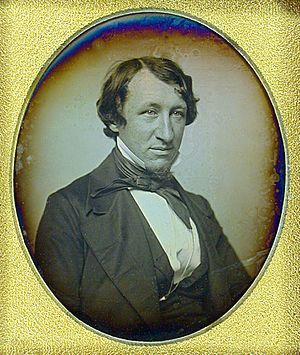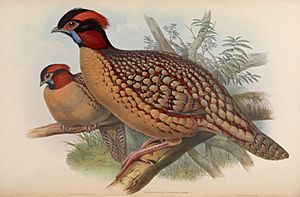Samuel Cabot III facts for kids
Samuel Cabot III (born September 20, 1815 – died April 13, 1885) was an important American doctor and surgeon. He was also an ornithologist, which means he studied birds. Samuel Cabot III came from the very rich and well-known Cabot family.
Contents
Early Life and Education
Samuel Cabot III was born in Boston, Massachusetts, on September 20, 1815. His parents were Samuel Cabot, Jr. and Elizabeth Cabot. His father, Samuel Cabot, Jr., and his grandfather, Thomas Handasyd Perkins, were among the wealthiest people in Boston during the 1800s. His brothers included James Elliot Cabot, a lawyer and writer, and Edward Clarke Cabot, an architect and artist.
As a child, Cabot went to Boston Latin School. He later studied at Harvard University, earning his first degree in 1836. He then went on to get his medical degree from Harvard Medical School in 1839.
Medical Career Highlights
After finishing medical school, Cabot traveled to Paris, France, to continue his studies. He returned to Boston in July 1841. In the winter of 1841–1842, he joined an expedition to Yucatan. While there, he became famous in the town of Mérida for performing eye surgery. He helped several people who had a condition called strabismus, which affects eye alignment. Cabot was one of the first doctors in America to do this type of operation.
In 1844, he opened his own medical and surgical practice in Boston. He worked there for the rest of his life. From 1853 until his death, he also worked as a surgeon at the Massachusetts General Hospital. He was a pioneer in performing abdominal surgery there. During the Civil War, he volunteered his skills as a surgeon. He helped wounded soldiers and inspected army hospitals.
Studying Birds (Ornithology)
Samuel Cabot III became interested in birds and collecting them when he was young. While at Harvard, he often hunted for birds in the woods and rivers near Cambridge and Arlington. His brothers, James and Edward, often joined him.
When he was in Paris, he asked James to send him as many bird skins as possible. American birds were popular among European collectors. He could trade them for birds from Europe and Asia to grow his own collection. During the Stephens expedition to Yucatan in 1841–1842, he collected many birds. Over the next ten years, he wrote notes and descriptions about them. He even identified at least a dozen new species that had never been described by science before.
In the 1850s, his busy medical work meant he had to stop publishing about birds. However, he remained very interested in ornithology until he died. William Brewster, another famous bird expert, praised Cabot's "remarkably keen and analytical mind." Brewster believed that if Cabot had continued his bird studies, he would have become one of the most important ornithologists of his time.
After Cabot's death in 1885, his collection of birds and eggs was given to the Boston Society of Natural History. Cabot had been the curator (manager) of the bird collection there for many years. He had also published many of his scientific papers in their reports. Later, his collection moved to the Museum of Comparative Zoology at Harvard. The original type specimens (first examples used to describe a species) of ten types of Yucatan birds that Cabot first described are still there.
Two birds were named in Cabot's honor by other scientists:
- Tragopan caboti (Cabot's tragopan or Chinese tragopan) is an Asian pheasant. It was first described in 1857 as Ceriornis caboti by the English ornithologist John Gould. Gould used a bird specimen that Cabot had lent him.
- Coereba flaveola caboti (now a subspecies of Bananaquit) was first described in 1873 as Certhiola caboti by Spencer Baird. This was based on a specimen Cabot collected on Cozumel island, off the coast of Yucatan.
Also, a type of tern bird that Cabot collected in Yucatan was first described by him in 1847 as Sterna acuflavida. This bird is often called "Cabot's tern" in English. As of 2022, the International Ornithological Congress considers it a full species (Thalasseus acuflavidus). However, most other experts still see it as a subspecies of the Sandwich tern (Thalasseus sandvicensis caboti).
Personal Life and Family
Cabot was an abolitionist, meaning he was against slavery. He served as secretary for the New England Emigrant Aid Company. This group worked to stop slavery from spreading. They did this by sending settlers who were against slavery to the Kansas Territory after the Kansas–Nebraska Act of 1854.
He also did other good works for charity. He volunteered at the Massachusetts Infant Asylum and the Home for Destitute Catholic Children in Boston.
In 1844, Cabot married Hannah Lowell Jackson (1820–1879). They had nine children together, though one died as a baby. Their children included the artist Lilla Cabot Perry (born 1848), the chemist Samuel Cabot IV (born 1850), the surgeon Arthur Tracy Cabot (born 1852), and the industrialist Godfrey Lowell Cabot (born 1861).




